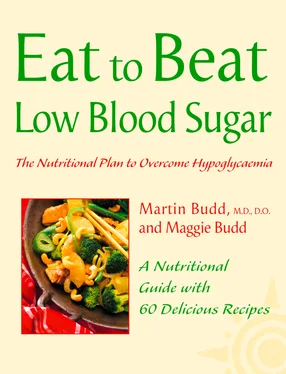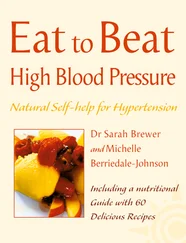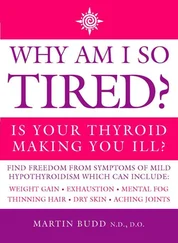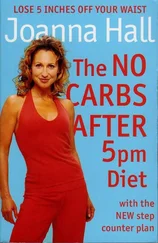This is a very complex subject but a brief list will serve to highlight the chief causative factors:
 Excessive sugar intake, leading to pancreatic overstimulation, hyperinsulinism and insulin resistance.
Excessive sugar intake, leading to pancreatic overstimulation, hyperinsulinism and insulin resistance.
Adrenal under-production, leading to adrenal deficiency or hypoadrenalism.
Imbalance and subsequent deficiency of the thyroid.
 Excessive use of tobacco (each cigarette smoked raises the blood sugar equivalent to 2½ teaspoons of sugar).
Excessive use of tobacco (each cigarette smoked raises the blood sugar equivalent to 2½ teaspoons of sugar).
 Excessive use of alcohol and caffeine – both serve to stress the adrenal mechanism.
Excessive use of alcohol and caffeine – both serve to stress the adrenal mechanism.
 Inability to handle prolonged or excessive stress, leading to adrenal debility and inefficiency (known in the US as adrenal exhaustion or adrenal fatigue).
Inability to handle prolonged or excessive stress, leading to adrenal debility and inefficiency (known in the US as adrenal exhaustion or adrenal fatigue).
Food allergies or intolerances, which can be caused by, but also aggravated by, low blood sugar.
 Mineral deficiencies. These include chromium, which is now deficient in the soil of Western nations. The minerals zinc, vanadium, magnesium, manganese and potassium are also essential for optimum blood sugar control.
Mineral deficiencies. These include chromium, which is now deficient in the soil of Western nations. The minerals zinc, vanadium, magnesium, manganese and potassium are also essential for optimum blood sugar control.
Hereditary factors, in particular a family history of diabetes, hypothyroidism, asthma, epilepsy, clinical depression or chronic fatigue.
When attempting to treat blood sugar disorders one key question that must always be considered is whether the patient’s low blood sugar is only a symptom, or is itself a cause of symptoms.
When low blood sugar is simply a symptom, it is generally the result of fasting, or transient, hypoglycaemia – low blood sugar that is caused by a delayed or missed meal. This is something we have all experienced; the symptoms include shakiness or dizziness and fatigue, perhaps a mild headache or a feeling of ill temper. Usually the symptoms are coupled with a strong urge for chocolate or something sweet.
Those who experience such symptoms on waking each morning usually have a background health problem. However, there are very few health problems that can cause us to feel worse on rising than we feel upon retiring. The list includes adrenal exhaustion, hypothyroidism, drug addiction and alcoholism. Those with severe food intolerances can also feel tired, thickheaded and irritable on waking – the reason for this is thought to be the early onset of withdrawal symptoms resulting from the night fast.
Reactive, or functional, hypoglycaemia
This problem is the main subject of this book. It defines a type of chronic low blood sugar that usually requires an appropriate dietary strategy and supplement use. The symptoms can occur at any time and, for many unfortunate sufferers, can be virtually continuous.
WHAT HAPPENS TO THE BLOOD?
The symptoms of low blood sugar can develop as a result of two principle changes in the blood sugar. These changes can involve either the actual low level of the blood sugar or the speed of fall in the blood sugar. Unfortunately the human brain cannot store glucose, so even a five per cent fall in the available glucose supply to the brain and nervous system can produce an adrenal response with subsequent symptoms.
WHAT ARE THE IDEAL GLUCOSE LEVELS?
The normal level of our fasting blood sugar (fasting refers to food avoidance for 12 hours) is 4–7mmol/L. Many diabetic clinics define a patient’s symptoms as ‘hypo’ if a patient’s blood falls below 4mmol/L. However, I have frequently seen great symptom variations in a patient’s response to low blood sugar levels, although generally I have found that a blood sugar level below 3.5mmol/L can predictably cause symptoms to surface.
The American doctor and nutritionist Carlton Fredericks, a renowned authority on low blood sugar, stated “when blood sugar drops as little as 0.25mmol/L below the normal for the patient , a profound glandular compensation may start’. However, as mentioned above, a low level of blood sugar is not the only cause of low blood sugar symptoms – an inappropriately rapid fall in the blood glucose can also give rise to symptoms.
SPEED OF FALL IN BLOOD SUGAR
A rapid fall in the blood sugar level (for whatever reason) in excess of 1.5mmol/L in one hour can produce symptoms of low blood sugar. These changes occur irrespective of the actual level of blood sugar, for example a fall from 7mmol/L to 5mmol/L in 30–45 minutes can often cause low blood sugar symptoms to develop.
Both of the trigger factors that cause low blood sugar symptoms – i.e. speed of fall and a general low level – are subject to individual variations. I have seen patients who appeared to be symptom-free with a blood sugar level of 2.5mmol/L and others with levels around 3.5mmol/L who could barely walk or talk.
Insulin-dependent diabetics can ‘hypo’ when they overdose on their insulin requirements in relation to food and/or activity. Glucometers are used to check their blood glucose levels. Early models were designed to measure high blood sugar levels, however the more recent glucometers can measure blood sugar levels as low as 1.5mmol/L with a finger-prick blood sample. Accurate results can be achieved within 6–60 seconds, depending on the model used.
The problems caused by too much sugar
The high-carbohydrate Western diet provides sugar far in excess of our energy needs. Consumption of sugar alone in Great Britain amounts to 27kg (60–65lb) per person per year. If you include the sugar-rich refined carbohydrates we eat (for example, sweets, chocolates, cookies, cakes, cereals, soda and cola drinks) then our total sugar ‘load’ can be as high as 90kg (200lbs) per person (the figures in the US follow close behind). In terms of calories, one teaspoon of sugar per day equals 100 calories per week, so the amount of calories consumed by someone at the top end of the sugar-intake scale is vast.
When we eat sugar, we either use it for energy needs, or it is stored as glycogen or fat. Marathon runners know that they need to consume extra carbohydrates three to four days before a race to provide stored fuel for gradual release during the race. Likewise, those who do heavy manual work can often avoid weight and health problems as a result of converting all their food (fuel) directly to energy.
The experience of the explorer Sir Ranulph Fiennes clearly demonstrates how important it is that we match our energy intake to our output. On an Arctic trek, Fiennes lost weight despite consuming 5000 calories a day. In spite of his high calorie diet, his energy requirements meant he utilized a total of 11,000 calories each day. His subsequent weight loss was therefore inevitable. Perhaps we could justify our high sugar diets with marathon running or polar exploration – not popular choices. Fortunately there are other solutions (these are discussed in Part Two).
Central to the problem of low blood sugar is the hormone insulin. Any rise in our blood sugar requires an insulin response. Insulin is a hormone secreted by the pancreas to lower blood glucose levels; it does this by transporting the glucose to the muscle cells and other tissues. Insulin is uniquely the only hormone to promote food (fuel) storage for future use. For this reason it is often termed the storage or fattening hormone.
Читать дальше

 Excessive sugar intake, leading to pancreatic overstimulation, hyperinsulinism and insulin resistance.
Excessive sugar intake, leading to pancreatic overstimulation, hyperinsulinism and insulin resistance.










